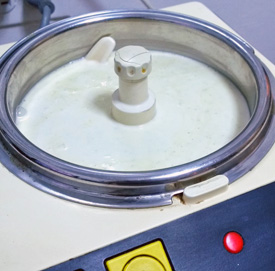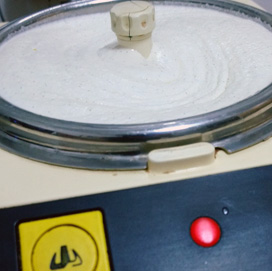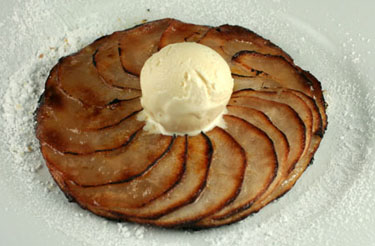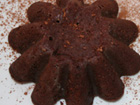Science of Ice Cream -- How to make smoother Ice Cream
What is ice cream?
Ice cream is both a colloid (a type of emulsion), and a foam. An emulsion is formed when the milk and cream are dispersed in the water and ice with the emulsifying agent usually being egg yolk, although commercial brand ice creams may use other agents (e.g., mono- and di-glycerides).The foam is formed as a result of air in the ice cream not mixing with the other substances but instead forming small bubbles in the bulk. Ice actually contains all three states of matter (solid, liquid and gas).
What are the main ingredients/factors that help keep ice cream smooth and creamy?
If you looked at ice cream under a microscope, you would see see ice crystals, fat droplets, and air pockets dispersed in liquid. This foamy mixture of liquid, solid, and air is crucial to ice cream’s flavor and consistency.
To help keep this foamy microscopic structure, ice cream contains chemical ingredients called “thickening agents.” These are designed to help foam stay foamy.
Fat content provides smoothness
Fat is one of the main components that provide smoothness to ice cream. The range of milk fat used in ice cream can go from around 10 percent to a maximum of about 16 percent. Most premium ice creams use 14 percent milk fat. The higher the fat content the richer the taste and creamier the texture. Egg yolks is another ingredient that adds fat. In addition egg yolks contain lecithin's (emulsifiers), which bind fat and water together in a creamy emulsion.
Air makes ice cream softer and creamier
The more air bubbles there are and the smaller they are, the smoother the ice cream will be. Large companies have machine s that can incorporate lots of air. Home machines are less efficient, but by running machines a longer time allows for more air to be incorporated resulting in a smoother ice cream (see images below). By leaving the machine on longer it is possible to mix in more air, however these long residence times (the time the ice cream spends in the machine) can significantly contribute to an increase in ice crystal size. Once your ice-cream mixture is semi frozen by the ice-cream machine then storing to harden the mixture in the freezer can also create larger ice crystals. A way around this is using a different type of sugar or add stabilizers.


Overrun is the measurement of air that is whipped into the ice cream and is calculated as the percentage increase in volume of the finished ice cream. Many commercial ice cream can have an overrun of 75-100%, however super premium ice creams may be as low as 20%. We need to keep Ice Crystals small
One of the most important goals of an ice cream maker is to make ice cream with many small ice crystals, resulting in a smooth texture, and to preserve that ice crystal size distribution until consumption. Ice cream's creaminess depends on the size of the ice crystals that form during freezing-the smaller the crystals, the creamier the texture. Rapid chilling and constant churning encourage the water in the ice cream mixture to form lots of minuscule "seed" crystals; this process is known as propagation. Ice cream containing lots of tiny ice crystals feels smoother and creamier than ice cream that is equally thick but with fewer, larger crystals. Constant churning helps keep the crystals moving as they chill, so they have less time to attach to one another.
Egg yolks are more than just an emulsifier
Heated Protein in eggs plays a major role. Heat causes proteins to coagulate into a thick gel which traps water. Heating an ice cream mix containing egg yolks to 70C improves body and texture. Low-density lipoproteins (LDL) solutions start denaturing at 70C. (See important cooking temperatures). Longer heating times will result in smoother ice cream because the water binding capacity of a denatured protein is greater than that of the native protein. However, if denaturation leads to aggregation of the protein (forming of clumps), then water binding capacity may actually decrease.
Controlling ice crystals with sugar
Freezing point depression of a solution is associated with the number of dissolved molecules. The lower the molecular weight, the greater the ability of a molecule to depress the freezing point because there will be more molecules present. Thus monosaccharides such as fructose or glucose produce a much softer ice cream than disaccharides such as sucrose. Most home cooks use only sucrose which results in a harder ice cream in the freezer.
Emulsifiers, Stabilizers and Thickening Agents
The original ice cream emulsifier was egg yolk. Emulsifiers keep the ice cream smooth and aid the distribution of the fat molecules throughout the colloid. Today, two emulsifiers frequently show up on the ingredients label of many ice cream formulations, namely, mono- and di-glycerides , and Polysorbate 80.
Stabilizers help hold the air bubble structure together and give the ice cream a better texture. Although gelatin was originally used as a stabilizer, xanthan gum, guar gum, and other compounds are used today. These stabilizing agents are usually a group of compounds called polysaccharides, that are responsible for adding viscosity to the unfrozen portion of the water and thus holding this water so that it cannot migrate within the product and form ice crystals.
Together, the stabilizers and emulsifiers make up less than one half percent by weight of ice cream. They are all compounds which have been exhaustively tested for safety and have and have received the "generally recognized as safe" or GRAS status.

VANILLA ICE CREAM RECIPE
2 vanilla beans
1 1/4 cups sugar
6 egg yolks
1 3/4 cups milk
2 cups heavy cream
Split the vanilla beans and scrape out the beans with the flat
part of a knife in a small bowl. Keep the empty
beans. Sprinkle some sugar over the vanilla mixture
and mix together to separate all the beans. Add
the remaining sugar and egg yolks and whisk the
mixture till light in color.
Heat the milk in a saucepan and add the empty vanilla
beans. Bring to a boil. Pour the boiling milk into
the egg mixture constantly whisking the mixture
vigorously. Return the mixture to the pan and thicken
it over low heat constantly stirring with a wooden
spoon, until the mixture is thick enough to coat
the spoon. Be careful at this point not to heat
to far or the egg will start to solidify. Pass the
mixture through a sieve to remove empty vanilla
beans and any other solids. Add mixture to ice cream
maker and freeze according to manufacturing instructions.
The ice cream can be made several days ahead of time and stored in the freezer.
Adapted from:
The Cuisine of Fredy Girardet
Fredy Girardet
William Morrow and Company, New York
Apple Tart from GreenmarketRecipes.com
